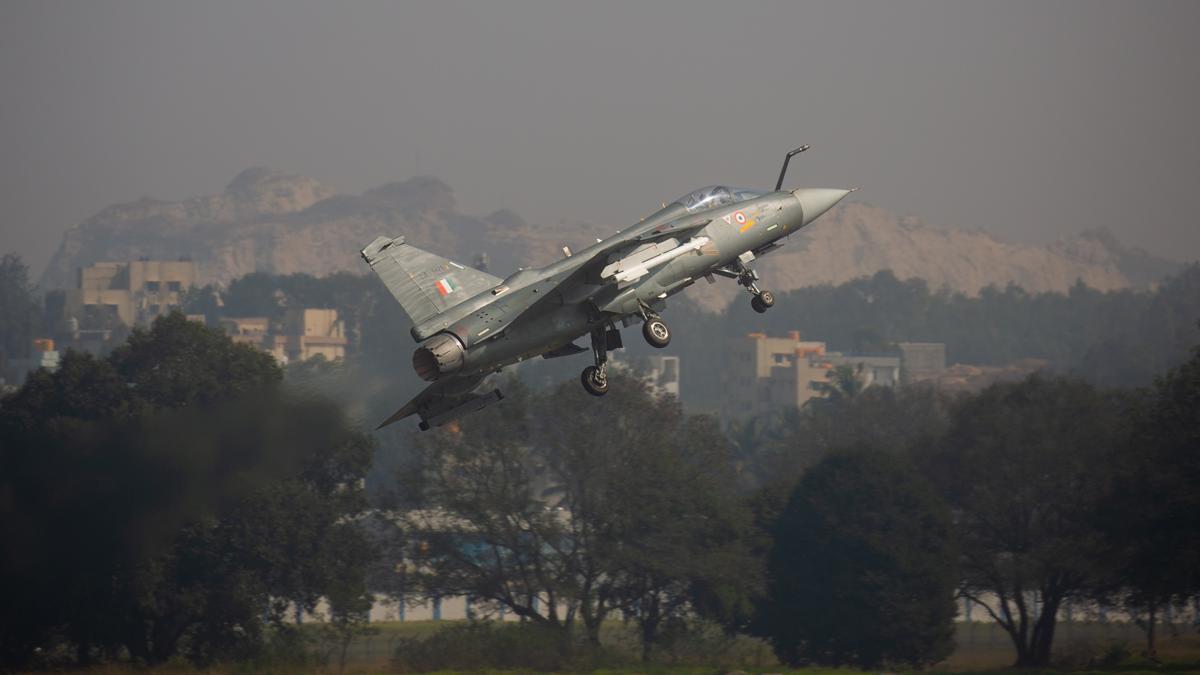
“New Delhi must ensure that its decisions ‘insure’ its interests against any U.S. policy reversal in the geopolitical environment that it is placed in”
| Photo Credit: Getty Images
It is no state secret that the defence public sector undertakings have the Indian armed forces as their captive customers. In fact, with the ‘Aatmanirbhar Bharat’ campaign, this dependence has only increased and has added to the stress of planners in the Indian Air Force (IAF) as they juggle with a depleting squadron strength in the IAF due to a poor production rate by Hindustan Aeronautics Limited. After the IAF chief made his angst clear at the Aero India-2025 show in Bengaluru in February, there has been a flurry of media statements about how a reinvigorated environment is now geared up to supply Tejas MK1A Light Combat Aircraft (LCA) jets. This month, the handing over event of the first rear fuselage for the Tejas, made by a private manufacturer — with the Defence Minister and the IAF chief present — has also been highlighted in the media.
Even as the report of the Ministry of Defence committee looking into the IAF’s needs (including imports) is being evaluated, there are three facts that should help keep us grounded.
SIPRI report and U.S. policy
First, the latest Stockholm International Peace Research Institute (SIPRI) report for 2020-24 shows that India is still the second highest arms importer in the world. However, the fact that India’s imports have reduced by 9.3% from 2015-19 is good news, but with a rider — expensive weapon systems such as aircraft, tanks, top end radars, and specialised armament, would continue to be imported for many more years and contribute to the import bill.
Second, the IAF has thrown its full weight behind indigenous fighter aircraft — LCA Tejas Mk1A, Tejas Mk2 and the Advanced Medium Combat Aircraft (AMCA), all of which are planned with American engines. The IAF’s kinetic operational potential would, thus, become a function of America’s calculations of India’s worth in its strategic calculus. Would India be weaned away from its heavy dependence on Russia, which contributes to 36% of its arms imports? The IAF’s inventory of 270 Sukhoi Su-30 fighters, S-400 missile systems and similar big-ticket items for the Indian Army and the Indian Navy stand out against a positive affirmation.
Third, the frequent coinage of fancy-sounding new policies in India-U.S. relations in the past two decades should keep India on its toes vis-à-vis their demonstrated short shelf life. Whatever became of the ‘Defence Technology and Trade Initiative’ of 2012 which was much tom-tommed, and also said to bring in niche cutting-edge technology and usher in a new paradigm in defence cooperation? Are we sure that the end result of the recently announced framework for the ‘U.S.-India Major Defence Partnership in the 21st Century’ would be any different considering the tempestuous churn in American foreign policy with a transactional new U.S. administration under President Donald Trump?
‘Partnership’ is the key word
There is historical reality to back this negative appreciation. The joint statement, after U.S. Secretary of Defence Ashton Carter’s visit to India in April 2016, said that [a] “defense relationship is a key component of the strategic partnership between India and the US.” Similar sentiments have been expressed recently after the Trump-Modi talks.
The key word is ‘partnership’. But the million-dollar question is whether two nations that are culturally, financially and with differing world outlooks, be true partners. An article by Anna Simons, Professor of Defence Analysis, in the Winter 2013-14 issue of the U.S. Army War College magazine, Parameters, says that “..a partnership can succeed only if it is grounded in mutual indispensability”, since “..anything less creates a dependency, and a dependency by definition is not partnership.” This raises the question whether India and the U.S. are indispensable to each other. And if they are not, then can Washington and New Delhi be true partners?
The indispensability factor can be tested by seeking answers to three pointers. First, are both parties equals, interchangeable and can blend seamlessly? Second, is a division of tasks possible for joint programmes? Third, can the expertise possessed by each nation complement and fill the gaps that exist in the other’s capabilities? A truthful analysis of their respective defence research and development and manufacturing sectors shows that there is great asymmetry in the capabilities, and the follow up can only result in India’s stifling dependency on the U.S.
But the same questions can be asked about the other relationships of India too, say with Russia, Israel or France. The answer lies in whether India has a political indispensability quotient in such strategic relationships or whether it is like the U.S.-Pakistan ‘partnership’ that broke when Islamabad outlived Washington’s geo-political interests and was dumped like a fly in a tea cup. Or, even the recent unravelling of the U.S.’s decades long and iron-clad trans-Atlantic partnership with Europe, leading to questions being asked about the reliability of the Trumpian friendship.
Looking ahead
This brings us back to the theme of this article. Are we heading the correct way as we look to the U.S. for our strategic armament needs? The answer, surprisingly, actually lies with Washington on whether the U.S. wants a ‘true partnership’, in which case it has to make India politically indispensable to itself (the U.S.) by imbuing a special friendly slant in our relations. On India’s part, New Delhi must ensure that its decisions ‘insure’ its interests against any U.S. policy reversal in the geopolitical environment that it is placed in. Even as India imports vitally needed aircraft and other equipment, its eyes need to be wide open to avoid a dependency that would negatively affect its strategic autonomy.
Air Vice Marshal Manmohan Bahadur (retired) is former Additional Director General, Centre for Air Power Studies
Published – March 28, 2025 12:08 am IST
